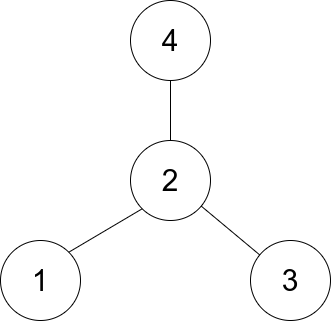- {x}
- Grand Slam Titles
- Check if Binary String Has at Most One Segment of Ones
- Minimum Elements to Add to Form a Given Sum
- Number of Restricted Paths From First to Last Node
- Make the XOR of All Segments Equal to Zero
- Maximize the Beauty of the Garden
- Primary Department for Each Employee
- Check if One String Swap Can Make Strings Equal
- Find Center of Star Graph
- Maximum Average Pass Ratio
- Maximum Score of a Good Subarray
- Count Pairs of Equal Substrings With Minimum Difference
- Rearrange Products Table
- Second Largest Digit in a String
- Design Authentication Manager
- Maximum Number of Consecutive Values You Can Make
- Maximize Score After N Operations
- Read More...

Find Center of Star Graph
There is an undirected star graph consisting of n nodes labeled from 1 to n. A star graph is a graph where there is one center node and exactly n - 1 edges that connect the center node with every other node.
You are given a 2D integer array edges where each edges[i] = [ui, vi] indicates that there is an edge between the nodes ui and vi. Return the center of the given star graph.
Example 1:

Input: edges = [[1,2],[2,3],[4,2]] Output: 2 Explanation: As shown in the figure above, node 2 is connected to every other node, so 2 is the center.
Example 2:
Input: edges = [[1,2],[5,1],[1,3],[1,4]] Output: 1
Constraints:
3 <= n <= 105edges.length == n - 1edges[i].length == 21 <= ui, vi <= nui != vi- The given
edgesrepresent a valid star graph.
Solution Explanation for Finding the Center of a Star Graph
This problem asks to find the central node in a star graph given its edges. A star graph has one central node connected to all other nodes. The solution leverages the inherent property of a star graph to efficiently identify the center.
Approach: Exploiting the Graph Structure
The key observation is that the center node will be present in all edge pairs. Therefore, we can simply examine the first two edges provided. The node that appears in both edge pairs is the center.
Algorithm
- Access the First Two Edges: Retrieve the first two edge pairs from the input
edgesarray. - Check for Common Nodes: Compare the nodes in the first edge pair with the nodes in the second edge pair. If a node from the first pair is found in the second pair, that node is the center.
- Return the Center: Return the common node as the center of the star graph.
Time and Space Complexity Analysis
- Time Complexity: O(1). The algorithm performs a constant number of comparisons, independent of the size of the graph.
- Space Complexity: O(1). The algorithm uses a constant amount of extra space to store variables. It does not scale with the input size.
Code Implementation (Python)
class Solution:
def findCenter(self, edges: List[List[int]]) -> int:
"""
Finds the center node of a star graph.
Args:
edges: A list of lists, where each inner list represents an edge
connecting two nodes.
Returns:
The ID of the center node.
"""
a, b = edges[0] # Extract nodes from the first edge
c, d = edges[1] # Extract nodes from the second edge
# Check if 'a' is in the second edge; if so, it's the center
if a == c or a == d:
return a
# Otherwise, 'b' must be the center
else:
return b
Code Implementation (Other Languages)
The same approach applies across various programming languages with minor syntax differences. The code snippets below showcase the algorithm's implementation in Java, C++, Go, TypeScript, Rust, and JavaScript. They all maintain the O(1) time and space complexity.
Java:
class Solution {
public int findCenter(int[][] edges) {
int a = edges[0][0], b = edges[0][1];
int c = edges[1][0], d = edges[1][1];
return a == c || a == d ? a : b;
}
}C++:
class Solution {
public:
int findCenter(vector<vector<int>>& edges) {
int a = edges[0][0], b = edges[0][1];
int c = edges[1][0], d = edges[1][1];
return (a == c || a == d) ? a : b;
}
};Go:
func findCenter(edges [][]int) int {
a, b := edges[0][0], edges[0][1]
c, d := edges[1][0], edges[1][1]
if a == c || a == d {
return a
}
return b
}TypeScript:
function findCenter(edges: number[][]): number {
const [a, b] = edges[0];
const [c, d] = edges[1];
return (a === c || a === d) ? a : b;
};Rust:
impl Solution {
pub fn find_center(edges: Vec<Vec<i32>>) -> i32 {
let (a, b) = (edges[0][0], edges[0][1]);
let (c, d) = (edges[1][0], edges[1][1]);
if a == c || a == d {
a
} else {
b
}
}
}JavaScript:
/**
* @param {number[][]} edges
* @return {number}
*/
var findCenter = function(edges) {
const [a, b] = edges[0];
const [c, d] = edges[1];
return (a === c || a === d) ? a : b;
};This efficient solution directly addresses the problem's constraints and provides a clear, concise, and optimally performant way to find the center node of a star graph.